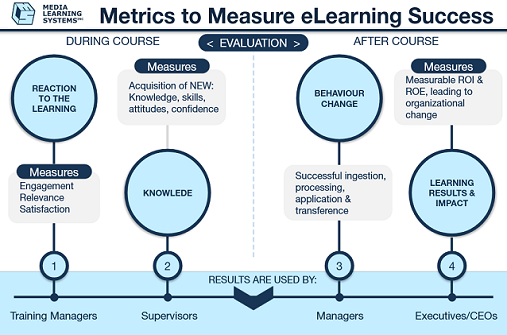
As a training professional, you have done your homework and developed a top-notch elearning course that has all of the bells and whistles you believe will help your workforce stay motivated and learn from the program. But how do you assess whether your online training is a resounding success or if it missed the mark? And how do you ensure your organizational management team appreciates and recognizes your efforts in creating the eLearning program?
The New World Kirkpatrick Model, developed by Kirkpartrick Partners, is a tool we use here at Media Learning Systems to assess success in eLearning. It is a robust, relevant model that has been updated to reflect organizational realities of 2021 and we have great success employing it after implementing our online courseware.
Let’s review the four levels of the model and then apply how each level could be used by your organization to assess learning.
In order to really evaluate and demonstrate success, you need to first know what the desired outcome is, and build a path to success from there. Therefore, we’re going to take the classic Kirkpatrick evaluation model and reverse it. This is the model that Kirkpatrick Partners now teaches and calls the New World Kirkpatrick Model.
It’s important that you evaluate the reaction to your training as quickly as possible. In fact, the three components of this level (engagement, satisfaction, and relevance) can be evaluated immediately after the online course is completed. For example, you can conduct post-training surveys at the end of the session, have pulse checks built in to the program, or have interviews with select participants afterward.
While this level is the most commonly evaluated, it provides the least valuable information for your program. Keep this in mind when you’re spending time on your evaluation; instead, spend more time on results, behaviors, and learning.
Did your program participants learn what you intended them to learn? This evaluation step is where you gauge whether or not your training provided employees with everything they need to modify behaviors and accomplish the goal of the training. In other words, it’s test time.
Reinforce the key takeaways of your program with a test. It’s also important to measure how confident and committed employees are to apply what they’ve just learned. This can be done with a post-training poll, an online survey that follows the eLearning course, or an open discussion about the training.
Behaviors are what make the difference between a successful training initiative and a flop. This is why you train, to adjust behaviors and actions in order to benefit your company.
Modifying behavior requires that you have management buy-in to hold employees accountable to the changes they’re making. Managers can do this by monitoring, reinforcing, encouraging, and rewarding team members who participate in the training program, or by simply cordoning off some time for them to take the course.
Keep in mind that not every behavior needs to be evaluated—focus only on behaviors that are critical to the results of your program. This means that the behaviors you’re attempting to adjust with your training need to be observable and trackable.
Did you ever find as a kid that doing mazes was easier if you started at the “finish” line? I sure did. This is the idea of backward planning, and it is an excellent model for evaluating your training program.
Think about what you’re trying to accomplish. Use your company’s goals and strategic initiatives. These are the results you’re looking to ascertain through your training program. Look for leading indicators, or signs that you’re on the right track with your program; some online learning programs offer to collect these data for you. These will also help you provide your directors with reports on your success.
The following is a quick review of the model and its various components:

As eLearning professionals, we recognize the inherent value of online training. Committing to and incorporating a comprehensive evaluation model for your training programs can demonstrate that value to the rest of your organization.
Despite this, many professionals only commit to evaluating the reaction and learning steps of the Kirkpatrick Model, never taking the time to evaluate whether the program had its intended impact or result. To provide better training, you need better data, and you’re only going to get better data if you shift your focus.
This shift occurs when you stop focusing on the return on investment (or ROI) we have been using for ages in the eLearning industry, and start focusing on the “return on expectations” (or ROE). By measuring ROE, you’re focusing your evaluation on the expectations of training versus ROI, which tends to focus on the financial aspect including cost breakdown of the program.
When we shift our focus to ROE, there is a collaborative effort and sharing of credit with other business units. Instead of everything being about training and what training has accomplished, it becomes about what the business has accomplished through training which in turn, changes the conversation to something meaningful across your organization.
Using models such as the New World Kirkpatrick Model will help you achieve better organizational success when it comes to your eLearning endeavours.
Please contact Media Learning Systems if you have further questions about this model or would like us to help you with evaluating your eLearning program.
We would love to quote on your next project, or just chat more about what makes successful eLearning with you.
Media Learning Systems Inc.
1 King West, 48th Floor
Toronto, Ontario
M5H 1A1
Copyright © 1996-2025, Media Learning Systems Inc. All Rights Reserved.